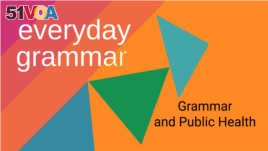02 April 2020
In recent weeks, public health officials have been making many statements about the new coronavirus and the disease it causes, COVID-19.
Officials give either very general or more detailed information about the virus. They often use certain kinds of words and expressions, and their explanations may include numbers or percentages. These issues will be our subject this week on Everyday Grammar.
Expressions of quantity

Expressions of quantity often appear in news stories about the coronavirus.
When speaking with reporters, experts often talk about numbers of cases in order to give people an idea of what is going on in their country.
One such expert is Doctor Anthony Fauci, director of the U.S. National Institute of Allergy and Infectious Diseases. Here, he is talking about the spread of the coronavirus in the United States.
"Importantly, there are a number of areas in the country that have relatively few cases – those are the ones that are vulnerable and dangerous ..."
You heard Dr. Fauci say the words "a number of" and "few." These are two important expressions of quantity. They are somewhat general in meaning. For example, a number of always means more than one, but it is unclear exactly how many a number of refers to. Similarly, the word few means more than one, but could be five, 10, or even more.
It is important to note that both of these expressions describe plural count nouns -- areas and cases.
In general, English speakers use a number of and few along with count nouns – nouns that can be counted.
In the example we heard, Fauci probably used these expressions of quantity because he was talking about general trends in the United States. He surely did not have the time to talk about specific numbers of cases nationwide. Such information would take far too long to give in a short interview with a reporter.
Grammar experts often talk about different kinds of expressions of quantity. Some of these, such as a number of, almost always have the word of. Other examples include the terms a lot of or lots of.
So, for example, you might hear a health expert say, "A lot of doctors are taking extra steps to keep themselves safe."
The word few is a little more complicated and harder to explain. Few appears in a different class of expressions of quantity. It sometimes appears in American English as a few, or even a few of. The word of only appears sometimes. And in some cases, speakers change the meaning of few with an adverb – as in very few or relatively few.
If you would like to learn more about expressions of quantities, be sure to read the story "How Much Do You Know About Quantifiers?" You can find it on our website, www.51voa.com.
Percentages
Now, let us turn to how a scientist or medical expert might give more specific information when talking about quantities.
One of the central questions about the coronavirus pandemic is this: how many people have to go to the hospital because of it?
Let's listen to an example. Here Dr. Payal Kohli tells about specific information from a report by the U.S. Centers for Disease Control and Prevention, also known as the CDC.
"Yeah, so the CDC report that just came out a couple days ago was a little bit of a surprise, because what we had mostly been hearing was that older people end up having ICU admissions and hospitalizations. But what it actually showed was that 38 percent of hospitalizations were people under 65, 48 percent of ICU admissions were people under 65."
Here, Dr. Kohli describes numbers related to hospitalizations and intensive care unit (ICU) admissions.
The ICU is a part of a hospital that provides care for very sick people.
Note that Kohli always used the word "of" following the percentage. So, she said "38 percent of hospitalizations" and "48 percent of ICU admissions."
The general pattern she used was percentage+ of+ noun.
You will hear this kind of pattern in all kinds of news reports.
For example, you might hear about an education report that says "25 percent of American college students have more than $10,000 in student loan debt."
Closing thoughts
The goal today was to show you a number of ways that health experts describe quantities. When you read or listen to doctors or other experts in the future, ask yourself how they are expressing quantities. Do they give general descriptions of trends, or do they give specific numbers?
When you ask yourself these kinds of questions, you will begin to see patterns in how people express different kinds of information.
Be sure to make note or record the patterns you find. Then try to use what you learn either in speaking or writing.
And that's Everyday Grammar.
I'm John Russell.
John Russell wrote this story for Learning English. George Grow was the editor.
We want to hear from you. Write to us in the Comments Section.
_______________________________________________________________
Words in This Story
certain – n. known for sure; unquestioned
quantity – n. the amount of number of things
refer – v. to mean; to direct one's attention to
trend – n. a general direction of change; a way of behaving that is developing and becoming more common
vulnerable – adj. open to attack, harm, or damage
pandemic – n. a disease that has spread across a large area
intensive – adj. involving very great effort or work
couple – adj. meaning two
pattern – n. the regular and repeated way in which something happens or is done